What's up with the bees? Everyone's been asking. Well, let's just get this out ... Today I checked on them and they appear to have died out. That's pretty hard to say, but it does happen. They were doing really well this year and just a few weeks ago, I was feeding them and they were numerous. But today, peeking in the window, the comb looks dark and dead and no bees are active. I haven't opened it up yet, I'm still steeling myself up for that job.
So, what now? I had been prepared for this moment for a long time. I thought I knew the answer, but now ... I've had a change of heart. This last summer I've noticed I am reacting more and more badly to the stings. They burn initially and I show no problems after a few hours, but later, for up to a week, I get a very itchy rash. Last time, a few weeks ago, it ran all down my neck. I tried denying it to myself, telling myself it was something else or just a one time thing, but I knew it really wasn't. Thus, I think I will quit while I'm ahead and let the bee idea go. That's a hard decision. I may entertain bees again in another way, say lending space to another beek and moving the hives out of range a bit.
This never was a necessity. I wasn't looking for lots of honey or pollination. It was just nice to have around. I've learned a lot, seen that the bumblebees are more active than I imagined, and witnessed an amazing honey bee swarm. Those things will never go away for me.
As for here, well I have been negligent in writing of late, but I plan on keeping with the gardening, cooking and occasional personal posts. So if you are reading here, please stop by once in a while and I may have something posted :-) . So, for now, a farewell to the bees. It's been fun.
So, a bit of delay in posting, but spring/summer was calling. After returning from the wedding we still had bees! A surprise was waiting however. The table in front of the hive and the surrounding grass were covered in dead bees. Hundreds of them. It was quite a shock. Normally, one would think of a pesticide poisoning or similar with a sight like that, but that was not likely as we were gone and their are no neighbors close enough for that. A closer inspection showed the dead bees to be drones. For some reason, they had kicked out and knocked off the drones. That, itself, is not unusual, at least in the fall, and can possibly happen if they are stressed for resources. I have no real idea what the cause was, though. At any rate, there were still some bees left, but not many.
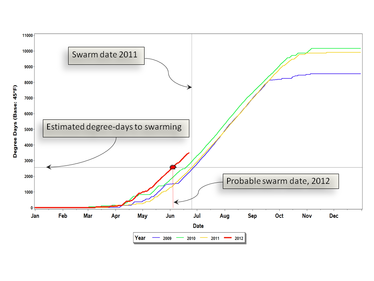 Did they swarm? I believe they did. And I believe they did so pretty close to the predicted time. Because the number of bees was so low, I think it is likely. I have also observed an open queen cell through the hive window (I haven't been able to get into the hive, though). You can see on the graph that since then we've sailed on by and are accumulating degreedays rapidly. What this doesn't show is the real change in weather we had. While we were gone and well after we returned, the weather was very unstable, wet and cool. A bad time for swarming!
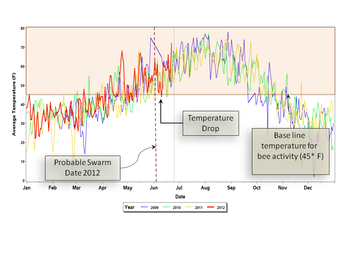 This has several consequences. For one, obviously the swarm itself will have a bad time of it, although they may have been fine. We'll never know. The remaining bees also have a hard time because they now have a new queen who needs to get out and mate. All the while, the bees need to collect food, etc. Stormy weather makes this difficult. This may be why the drones were sacrificed.
The whole scene was, frankly, pretty depressing. Checking the bees through the window in the cold weather showed only a small pathetic cluster. When the weather warmed, though, they showed a fair amount of activity, hitting the raspberries hard and flying off to unknown places. Time (and a good inspection) will tell. For now they seem to be recovering and pretty busy.
 Meanwhile, we have gotten the garden up and running. And yes, we do have tomatoes! Lots of spinach, lettuce and potatoes. I had a lot of trouble getting carrots to take this year, but upon replanting some again (3rd time) this morning, I noticed several ants happily carting off the seeds I had scattered, so that may be the explanation. That's expensive ant food! I'm trying melons too, although the don't seem happy in our soil and they need to grow fast around here. Worth a shot, though. The blackberries along the beeyard are about to bloom, so that will be good food for them and us. Perhaps I've been impatient this year, wanting to get everything going. It seems like a long slow start, though. Gardens and bees seem to just take their own course and sweet time no matter how hard I try to predict and promote them.
Time. We think of it in hours days and weeks. The bees, of course, have no such calendar system. They seem to follow another more intrinsic schedule. This too, however, is a misnomer. Bees, instead, simply grow and develop according to what the environment around them provides. Because they are cold blooded animals, they depend on the environment for warmth. Although they can purposefully generate heat for themselves in the hive, outside of that enclave, they are at the mercy of the elements. Likewise, the resources they take from the environment, nectar and pollen, come from sources, plants, which also depend on the surrounding environment for warmth. As winter moves to spring and then on to fall, the ambient temperature rises and falls.
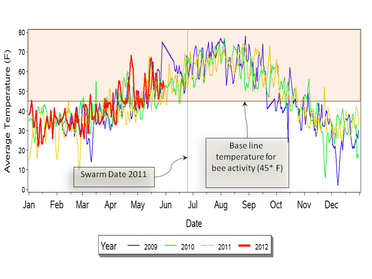 This plot shows the average temperature for the last three years and the current year in Deary. Although the rising and falling pattern is evident, a lot of shorter term daily and weekly variability is present to. For bees, the critical temperature comes in at about 45*F. Anything below this and they will be static, in a thermal stupor, unable to move. Once the temperature climbs above 45, they will become active. The hotter it gets, the more active they will be. On the plot, I have highlighted the portion above 45*. This is what the bees use. To measure their “time” then, we need to figure out how much time and to what degree (literally) they have been above that temperature.
 Such a measure, commonly used by biologists, is called degreedays. There are various ways of calculating degreedays, but a simple quick and dirty method is to just add up the average temperatures, accumulating them over the days of the year. Any averages below the magic 45* level are set to zero. At such temperatures, the bees get nothing from the environment. A plot of these degreedays is shown here. We now have a common scale to compare years. In cool years, such as 2011, the degreedays accumulate slowly at first. Warmer years like 2010, go up faster. At any given degreeday level, the bees have received equivalent amounts of energy from the environment, and by implication should be at similar stages of development.
I have a particular point of development in mind: The infamous time of swarming. I know the date this occurred in 2011 and can infer from this the degreedays needed to achieve that. It turns out to be about 2500. Hence, thoughout the current season, I have been watching the degreedays build and climb towards the 2500 mark. We are getting close now. And my little trick of math and weather seems to be playing out. The last couple of days, I have noticed the bees suddenly becoming active at about 1:00-2:00 in the afternoon (the timing is always very close to this). They swirl out of the hive and buzz in wide circles around they hive. Many will also come out and crawl on the face of the hive. It is very loud, easily discernible, even from the front yard. They don’t actually swarm, but I believe these are trial runs, practice if you will, as they prepare for the event. So it looks like the degreeday model may work. Unfortunately, if you trace the red line up into the future, it looks like things may happen when a certain someone is getting married and we are away for the weekend, so alas, the best laid plans and predictions may be foiled. Still, I was pleased to see things get this close. There’s always next year!
Lying awake in bed, reading on the computer. It’s late, but I can’t sleep. It’s the first hot night we’ve had. An anomaly that is Spring here. The ceiling fan is on high and brings some relief. Something in the window catches the corner of my eye, but I keep reading. There it is again, … a bright flash in the distance. A storm is moving out there, somewhere. I turn, now distracted, and watch out the window. Another flash illuminates the clouds on the horizon. I pick up the computer again and pull up the weather map. Amorphous green and red blobs march in a string across the animated map. They’re progressing this way, towards the little “pin” that marks our spot on the map. I put the computer away and turn out the light. I should be unconscious by now. My body aches with the onset of spring weather and the yard work it brings with it. My mind refuses to play along, however. I roll on my side and stare out the window. The flashes are brighter and more persistent now, accompanied by the distant low rumbling of thunder. I close my eyes, willing myself to sleep. Through my eyelids I am still seeing the flashes. I resume looking out the window. Without warning, a blazing bolt of lightning arcs across the sky, strobing several times, revealing every detail of the low hanging clouds, the barn, the grass … and then it’s gone, leaving me momentarily blinded, my eyes searching in the darkness for shape or form, but only finding after images of that last flash. The thunder takes several seconds to arrive, beginning with a loud crack and tailing off into staccato booms.
I remember excitedly watching storms as a little boy. From our house on a hill, I could watch them roll off the Front Range, striking the dragon shaped Cheyenne Mountain in the distance. My enthusiasm for them has waned some with the responsibilities and concerns that are acquired with adulthood, so the show outside now makes me restless. I think to myself how different this is from last year when we had a snow storm on this day. Then again, who knows what next week will bring.
Soon rain begins to splatter on the windows, the wind throwing it in spurts against the glass. A loud boom shakes the house. Wendy raises her head and looks over at us. Beth calms her and she lays her head down again. Eventually, the quick moving storm starts to subside as it passes by. I close my eyes again, thinking of the garden we worked on planting today. The warm weather had encouraged me to get things going, so we put most of the seeds in … peas, carrots, lettuce, spinach, potatoes, in addition to some flowers and borage for the bees. A bit more to follow when it really gets warmer, but a nice start. With the storm finally quieted down, I start to fall to sleep thinking of the garden and the nice rain it is getting now. A good beginning to this year.
The days are finally warming a bit. The usual spurts of cold rainy days are still here, for sure, but the days are getting longer and warmer. A welcome time for bees and barn cats too!
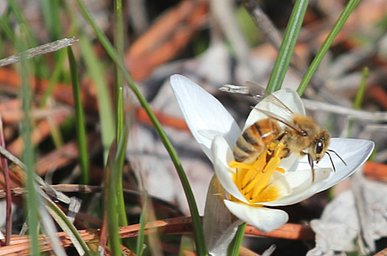 The bees really like these little crocus flowers. We have a small patch out front.
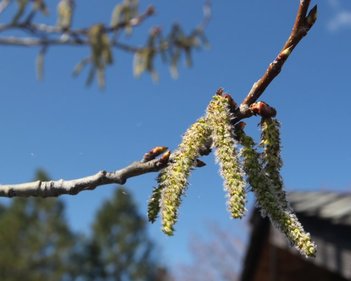 The crocus started blooming a few weeks ago and, when they could, the bees were on them. They had evidently found other things as well. Watching the hive I found a lot of pollen moving in and trying to track the path of the bees, I could see that they were busy flying off to the north and south where we have neighbors with something blooming. Not much is out right now, with the exception of some deciduous trees like aspen which can produce a bit of pollen. The collection of pollen is a good sign as it indicates the bees are busy feeding young.
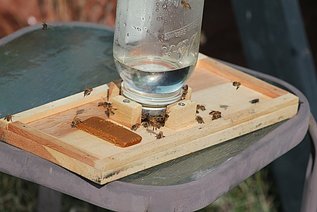 It seems the number of bees has been increasing a bit and I have been feeding them with a feeder outside the hive when it has been warm enough. They suck down these quart jars of sugar syrup pretty quickly. I'm inclined to back off on those some now as things are starting to bloom more. Looking in the window of the hive, I can see they have been busy and not all of their activity is to my liking. They sometimes have a tendency to build comb across the bars in a perpendicular fashion. While this is natural for them, it makes maintenance of the hive difficult. Hence, it is time for some spring clean up.
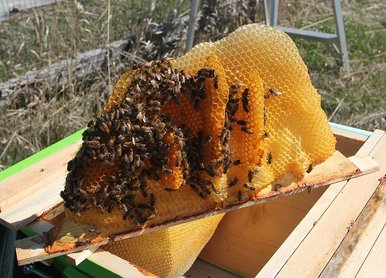 This weekend, one year since installing this hive, I opened things up and went through the hive comb by comb. Here is an example of cross combing. A kitchen knife is use to slice off these comb spurs. They will repair the cut ends and, hopefully, avoid the crossing again. I also finally took out the old queen cage from last year. I'll melt this wax down and do something with it. It smells quite good actually.
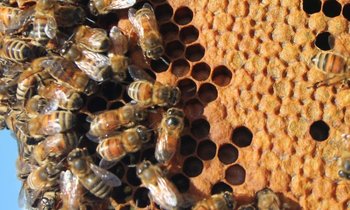 There was a fair amount of capped brood ready to hatch out, as well as the puffy drone cells that hold the males. I did not directly see the queen, but that's not unusual for me. I miss half the stuff I'm looking at anyway, which is why I take lots of photos. I took out the feeding station I had placed in the hive previously ( see here), and moved the combs all down to one end of the hive to open up the rest of it for the anticipated summer bounty.
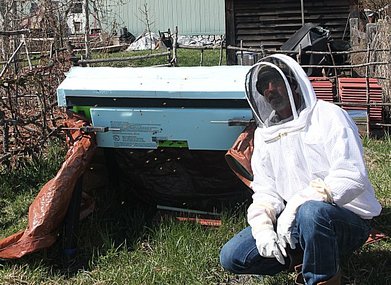 All in all, the bees were in good behavior through the whole process and I think we are now ready to proceed into the rest of the season.
Once, a lifetime ago, I started the study of general biology and agriculture. Although it had a good deal of interest for me, there was no real personal direction to it at the time, just the predetermined, one size fits all, study plan laid out by an adviser. Thus, in my first year of school, I found myself enrolled in an introductory animal science course. This is the type of class that covers the gamut of animal life from microscopic critters to whale sized ones, full of memorization of fact and theory. The class was huge, well over 100 students, all neatly seated behind row after row of long curving tables arranged like a tiered academic coliseum. The lecture hall was newly built and had that modern, clean, somewhat impersonal, feel to it. The crowd of students murmured loudly as we waited for class to start. Far down in front on the "stage", two rolling blackboards were lined up, one with ‘AN SCI 101’ written in large bold letters across it. Soon a small figure walked out to the podium setup in front of the blackboards. Looking up at the crowd, the figure began speaking in a cutting voice announcing the beginning of class. The voice was not particularly loud, but it was very distinct and immediately silenced the crowd of students. Such was my introduction to Professor Madam Frances Lechleitner. In appearance she was a small, aging figure, and, at that time, she was surely close to retirement. But her energy was never lacking. To my newbie undergraduate eyes her attitude was outwardly crusty, no nonsense and to the point. It was both intimidating and inspiring, evoking a sense of respect and admiration. I have vivid memories of her stoically smoking a cigarette behind the hall after lectures, obviously concentrating on some current problem. Being a world authority on termites she was well respected and accomplished in the field, yet here she was teaching an introductory freshman class that others would have shunned. Whatever her reasons, when she spoke, you listened. So, when we were halfway through the semester, and she matter-of-factually stated "Whatever your field of study is, whether social scientist, biologist, or engineer, you need to take a class in entomology. Insects are everywhere in the world and you need to understand them", I listened! I immediately resolved to add an entomology course to my pre-set list of classes. I didn’t realize it at the time, but my ambling course through biological disciplines had just ended and had now taken on a distinct direction, one that has influenced my path ever since. Through the years I have found entomology to be fascinating, encompassing any imaginable possibility of form and function. The array of diversity is stunning. And while my personal path has taken me elsewhere, I am occasionally reminded of the wide-eyed enthusiasm and wonderment that drove me then.
 Thomas Seeley is such a reminder. He is a bee behavior researcher and has an amazingly creative ability when it comes to experiments with bees. And experiment he has. A lot! Starting in graduate school about the time I was just beginning with Dr. Lechleitner, he has since studied the hows, whys and whats of bee foraging and bee swarming. What is more, he has done something few researchers have. He has collected all the research, papers and findings together into two books. Even better, he has written them in a semi-technical manner making them readable to anyone with a general knowledge of biology. His first book on foraging activities and behavior ( The Wisdom of the Hive: The Social Physiology of Honey Bee Colonies) is, unfortunately, very expensive and probably best obtained through a library. His second and most recent, however, is on bee swarming behavior and is much more reasonably priced. This book, Honeybee Democracy , follows his interest in answering questions regarding how and why bees swarm from an established colony and, most importantly, how they decide on a new home site. When a set of bees and queen swarm from a hive, they innately know what they are looking for in a new home. One of Seeley’s quests was to figure out what those home selection criteria are. Through a series of creatively setup choice tests, he determined, among other things, that the volume of a hive site should be at least 40 liters. They may take up in a smaller space and they can certainly fill a larger one, but if given a choice, they will opt for the 40 liter size. So the question arises: how big are beekeeping hives? One deep section in a typical Langstroth hive (the box type hives everyone is familiar with) is about 47 liters and, since Langstroth hives have multiple sections, they can easily meet this requirement. What about the top bar design? Measuring out the elongated trapezoidal shape of my hives, I was unsure they would make the cut. On final computations, however, I came up with about 57 liters. So, it looks like the size should be 'comfortable' for them. Not really a pressing problem at the moment, but a curiosity, none the less. After all these years, you see, I am still thinking about entomology...
Well, as usual, Idaho spring did not disappoint. We were greeted with 10" of fresh slushy snow on the first day of spring. Hope those girls have the wood stove stoked up in there!
The empty Blue hive ...........
The garden. I really could see the ground there last week! Wouldn't know that now.
While a lot of the country has been dealing with violent weather, we escaped and have had typical, almost spring, type sun/snow/rain/wind ... usually all within an hour of each other. Today was a bit of an anomaly, however, as the sun was out, the wind was moderate, and the temperature vaguely reminiscent of warm. When such weather strikes, I always head out to check the hive for signs of life. I had actually checked in on them yesterday when it was cold. I could faintly hear a low buzz from within the hive, so I knew they were still kicking. But today, they were out in force, flying about and taking care of business.
Several things are going on here. First, I put some sugar out in a plastic lid, just in case they needed it. Few bees took up the offer, however, which I take to mean that they don't need it yet. The bees that were flying were typically stretching their wings and, ... well, taking care of business. 3-4 months is a long time to be cooped up in a hive, and while the bees are good at holding it, they obviously like the opportunity to take some relief. These are called cleansing flights for that reason. The other main activity was cleaning the hive, which is primarily morgue duty hauling off the dead. Many bees will expire during the winter and bees like to tidy up when they can by removing their passed sisters. That's what the pile of bees on the table is about in this picture. They could also be seen flying away with the dead bodies, dropping them further from the hive.
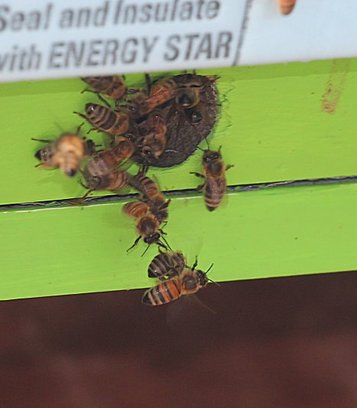 The bottom bee here is hauling off a dead sister (greyish bee above it).
All in all, the hive was singing loudly and seems to be surviving the winter OK so far. We have a couple of months to go here before real spring comes along, but this is encouraging.
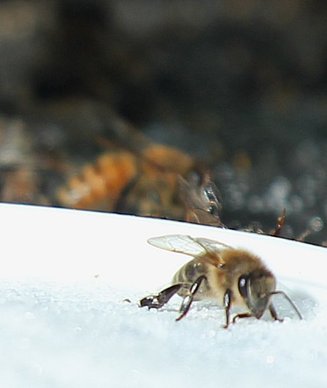 This bee was checking out the sugar I left, but most did not.
_ I glance across the headlines in the paper. It's the usual. Good things seem to rarely come up there. It is always something bad or tragic happening to someone else, somewhere far away. Like most people, I seem to try to keep it at a distance. Surely good things must happen out there. Maybe to prove it to myself, I spend a bit of time before the holidays giving out baskets to those working on the late nights and times when everyone else is out, able to relax and enjoy themselves. The baskets are nothing special, just some pastries and fruit with a little holiday cheer, but hopefully, a way to also say thanks for being there.
Admittedly, there is a selfish motive as well. I've always been one to troll for a smile where it is least expected. So, on the morning before Christmas Eve, I find myself out driving around town, gathering goods and balancing baskets on the car seats and the dash board getting ready. The first stop is at the police station in our small town. The reaction there is limited as everything is boarded off and insulated from the public anymore. I hand the basket to a clerk through a small sliding glass window with a "Merry Christmas". My hope is that some will get to those out on patrol all night and I tell the clerk to save some for them. He nods and thanks me, obviously a little confused by the process. A similar scene plays out at the Sheriff's office. Thankful, but a little bewildered. Next is the fire station. It's all volunteer here. They have a doorbell that I ring. The chief comes to the door and I hand it to him. "Hey! Thank you! I'll put this out on the table for the guys." I smile inside as I know some of the "guys" are actually "Gals". Last year I was greeted by a cute blonde sliding down the pole to come to the door. At 53, I don't think I can expect to get that kind of greeting much anymore ....
_ I realize now that I have been putting off the next stop for last. It's hard. The hospital is simultaneously my least favorite stop and most anticipated. My memories here are still strong, but the emotion and reaction I get here are the most raw. It's the place where unexpected pleasantries are the most appreciated.
I walk through the doors, past the receptionist, who greets me with a smile. I feel surreal walking down the bright, stark white corridor with a big red Santa hat and overflowing basket of stuff. It feels like everything is in slow motion ... the walking .... the breathing, the woman walking past. I know her. She's a waitress in town, but she is distracted and does not recognize me in my get up. I reach the elevator and push the button for my destination, the ICU.
It's here that I've found the most appreciation, where the emotions and stress are constant, and where I hope I can inject a bit of cheer. Riding up the elevator I know what will come. The nurse at the desk will look up and, with a detached, professional voice, simply state "May I help you?" They see a lot come through those doors, so finding themselves facing a middle-aged, balding man in a Santa hat with a basket of goodies is unlikely to throw them. Then I'll tell them, "No, I just want to drop this off." The first reaction will be a brief glimpse of relief as they realize that this is easy and I am not another problem for them to fix or deal with. Then, the real magic starts as they realize that I am looking at them when I hold out the basket. It is for them, not someone staying here, nor their relatives. Just something to leave on the desk for them to enjoy when they can. The looks and smiles are what you see on a four year old when they first spy the presents under the Christmas tree. For that brief moment, they smile and relax.
The automatic doors slide open to the ICU. I look up, but the desk is empty. I contemplate just leaving it there for a moment. A doctor is off to the side some distance away talking with a couple. I decide to wait a bit. I know this music. The look on the couple's face is familiar as they are trying to comprehend how their life is changing with the information they are getting. The doctor is smoothly going through the details with a practiced voice that is both professional and empathetic.
I turn away and pretend to study a painting on the wall. Soon the couple walks past and out the door. The doctor turns his attention to me ..... The line comes ...."May I help you?" I'm unprepared, caught up in my own thoughts. "Uh, ... I just wanted to leave this here for you guys.", I stutter. "Oh!" "Well, thank you!" he says with genuine appreciation. "Who is it from?" "Oh that doesn't matter. Have a nice Christmas." I say over my shoulder as I quickly turn away and start out the door. I can see him smiling and peaking in the basket with anticipation.
The doors slide open and I almost bump into a nurse coming in. Her hair is a bit disheveled and her eyes are red and puffy. She is wiping away tears, but quickly tries to gain her composure when she notices me. She looks up at me as we pass, trying to comprehend the unexpected Santa clad face looking back at her. "Merry Christmas!" I tell her, already knowing she is far beyond that cheer right now. Her eyes are searching and haunting and stay with me as I get back on the elevator. Hopefully she'll get a smile from the gift I left too. I ride down to the ground floor in awkward silence with the couple. Back in the car I just sit, shaking and trying to hold back the tears and get a hold of myself. I keep seeing those eyes look up at me......
Sitting on our comfortable couch with the dog curled up next to me, I find my eyes are drawn back over the headlines again. I read one. "Two girls killed in a head on collision with a logging truck". I cringe, but continue to read the short paragraph, now that I'm hooked into the story. At 7:30 in the morning, the young girl driving had drifted over the center line and hit a logging truck. She died immediately and her sister was taken to the hospital where she died later. A third sister survived with minor injuries ....... It starts to sink in as I make the connection to the events of my morning. I try to imagine the family who lost two daughters on the eve of Christmas. The sister who will never know why she was the one to survive. The truck driver who will be left always wondering if there was something he could have done. The Sheriff's Deputy responding to the scene. The nurse looking up at my silliness with those eyes. Those eyes..... I give Wendy a hug and feel comforted by the warmth of her soft fur.
 _ I know. This is pretty distressing and sad for a blog post. But for me, it was also a reminder to appreciate what is here now, to take advantage of opportunities in front of us. To enjoy those around us. To stop being angry with all my stupid, petty 'problems' and to look around me once in a while.
Nature is telling me this too. Winter, so far, has been gentle. A bit cold a times, but not her worst. Last week it warmed unseasonably with a brilliant clear day. Wendy and I took a stroll out in the yard, surprised at the unexpected bright sunny day. "What is that?" We are greeted by a familiar, but unexpected sound, some how out of place in the brown silence of winter. It's a loud buzzing. Zooming and zipping past in all directions were the bees. Surprised at their presence, Wendy whips around fruitlessly snapping at a passing bee. The bees know when to take advantage of the opportunity and they were out enjoying the temporary freedom from their confined slumber. We put some sugar out for them and a few took up the offer. It was a glorious sign of life in the dead of winter. I'm glad those dang bees are around.
We wish everyone a happy holiday season. Be safe and enjoy the coming year! I'm sure it will be full of unexpected gifts if you take the time to look for them.
_"Go Away!" "Go on, Shoo!" I'm swatting at an annoying girl buzzing around my head. This is clear across the yard from the hive, I'm no where near it, yet she is persistent. Others are hovering around as well, threatening to take up their sisters plight. No matter where I am in the yard, they are there. They are at the back door and windows, scanning along the seams, looking for an opening. They are in the garden, by the oven, seemingly buzzing overhead in all directions. Wendy takes a fruitless wild snap at one as it flies by her. We've both about had our fill of this. The behavior is not really aggressive, but it is annoying. They have been this way all day. Earlier in the morning, Beth and I cracked open the hive to prep things for winter. Basically, I wanted to recenter the combs in the hive and make room for the feeder again on the end.
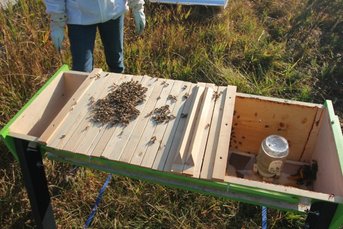 _What we found was a bit disheartening. Much of the honey they had stored seemed to be gone, either having been used prematurely, or stolen by raiding bees. I doubt the later as there are not any other hives close by. Hence, with their stores low, the girls were a bit touchy about us disturbing them, but it was necessary. Now, as I busy myself around the yard cleaning up for the coming winter, they seem determined not to let me forget our earlier transgression.
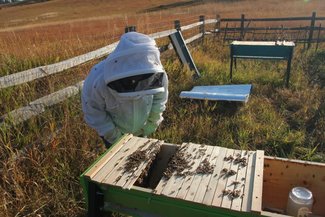 _That was a few weeks ago. since then I have tried to feed them regularly. Not an optimal situation as sugar water is an incomplete surrogate for honey, but it is the only choice I have. I could buy some honey to use, but that would be expensive and potentially problematic with the possibility of exposing the bees to an outside disease. I did try supplementing the syrup with a specially formulated protein powder (MegaBee), so hopefully that will help, but my expectations for survival this winter are low. It has been bothering me, which is probably why I have put off writing this. I feel a bit like a kid who's let his pet hamster die. But, I can only try, I guess!
Our fall was short and winter is bearing down now. As I write this, it is 16* F out and the forecast is for more cold and snow. We have had a bit of the later already and I got to hone up my shoveling skills some. My joints gave me pointed reminders why older people migrate towards the equator later in life. It could be a long winter ......
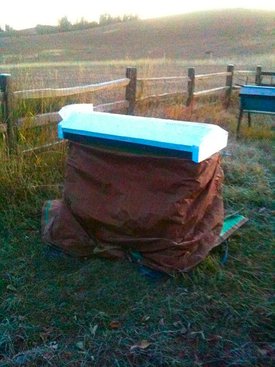 _I did button down the hive hatches prior to the cold, however. I picked up some blue foam insulation board and covered the sides and roof of the hive with this. I also wrapped the legs of the hive with a tarp to help keep the wind out. The front entrance is still open, although I have plugged two of the three entrance holes. The girls are still there, actively milling around the entrance when I disturb them changing out their food. They have surprised me before with their robust survival ability. Still, April and May seem a long way off.
|



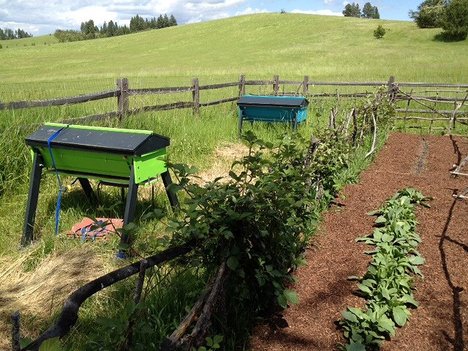


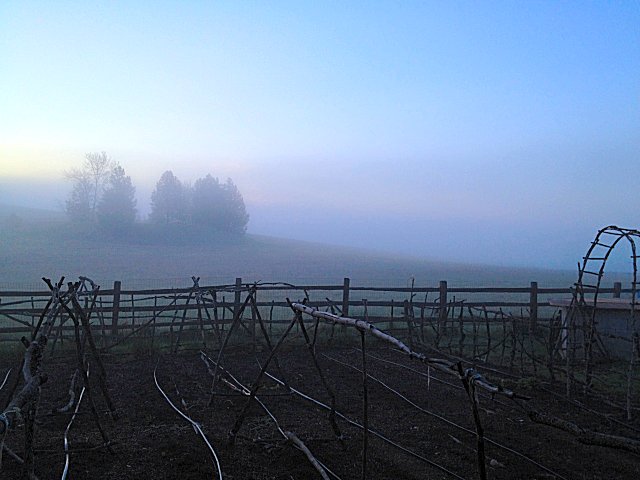

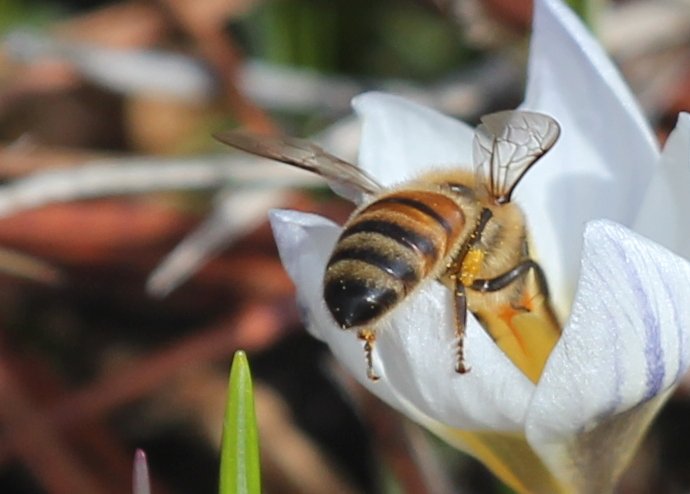
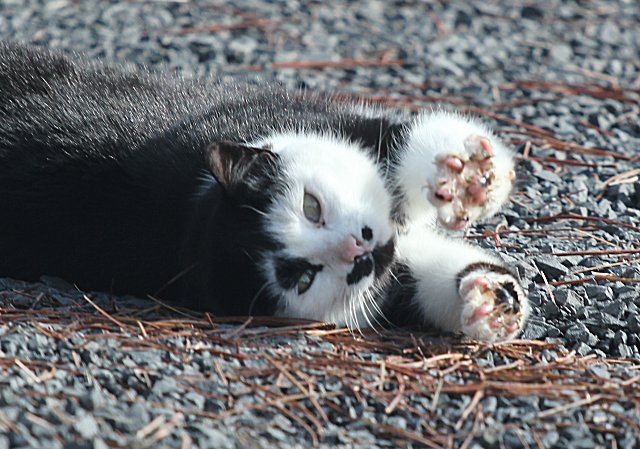


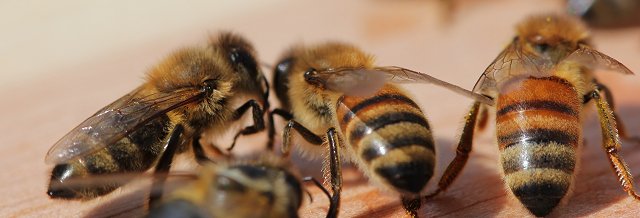
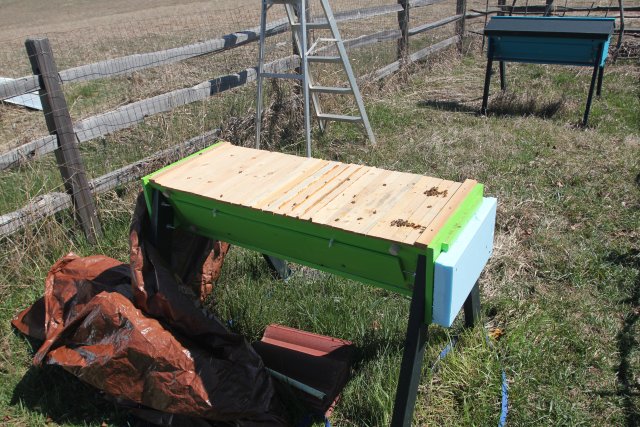

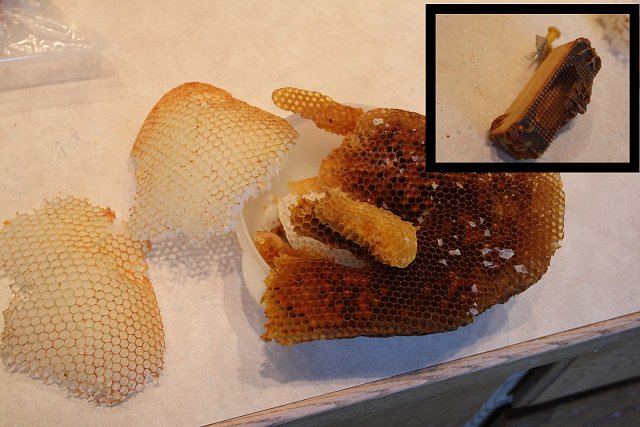

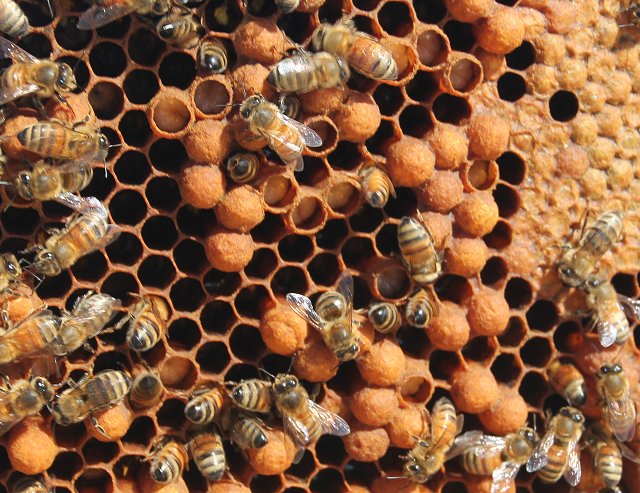
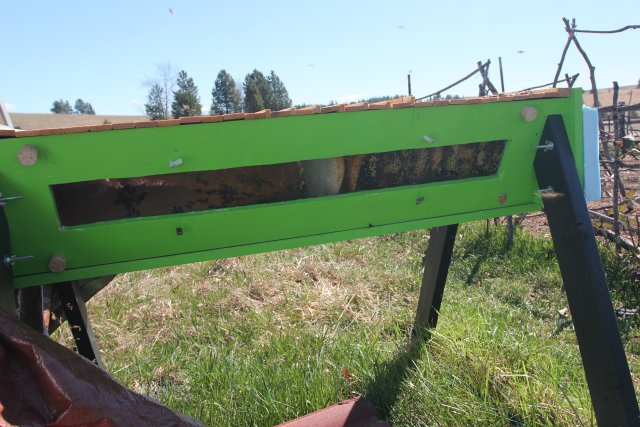

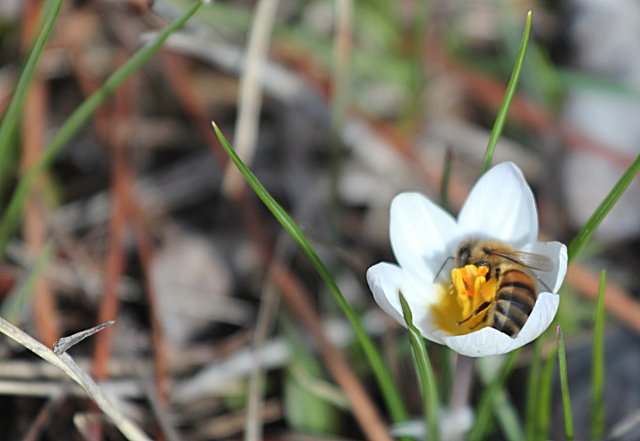


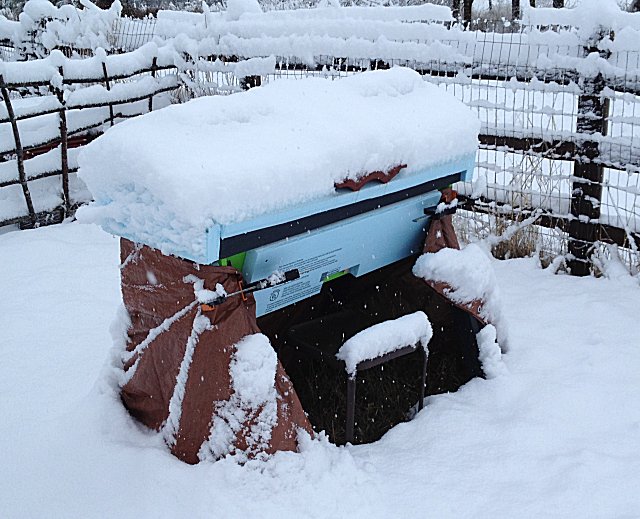
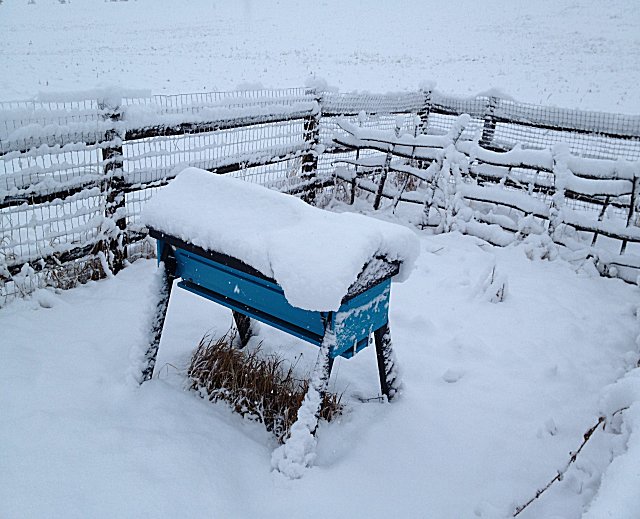
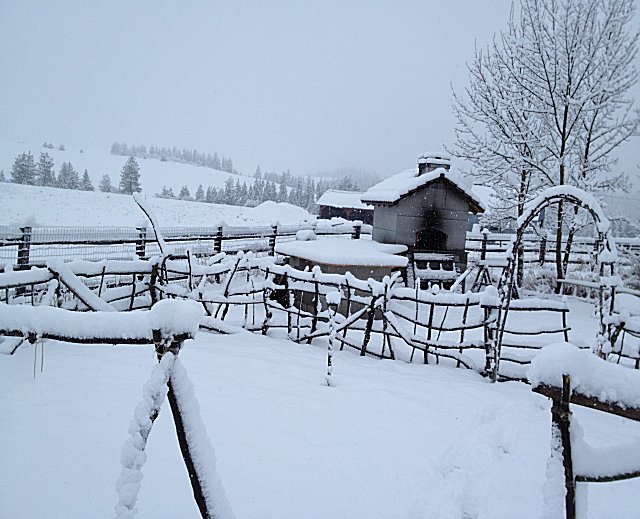
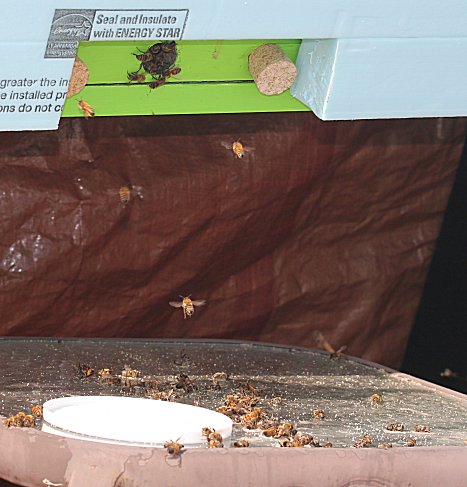




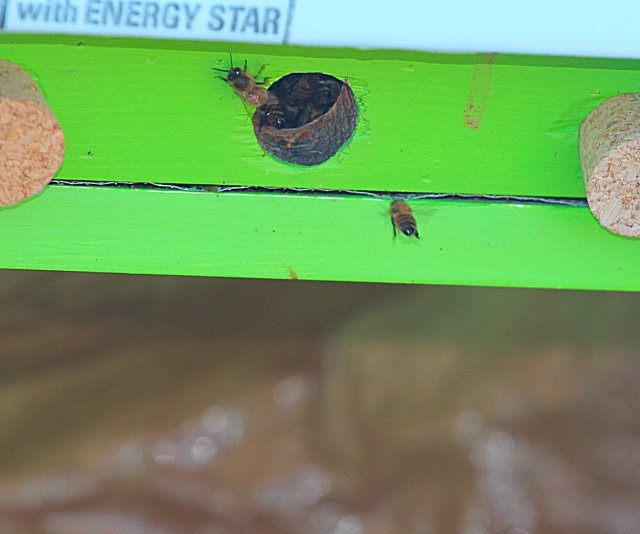



 RSS Feed
RSS Feed